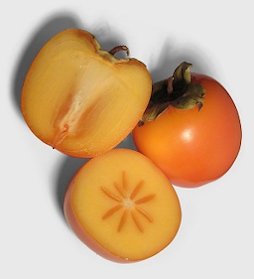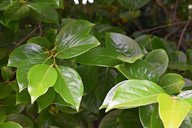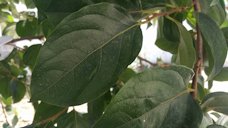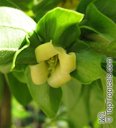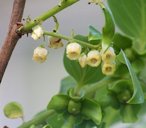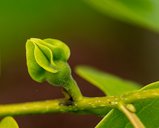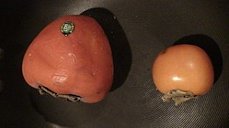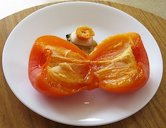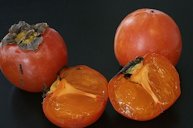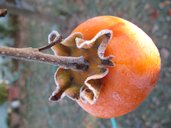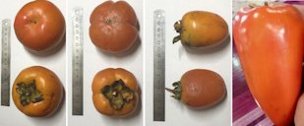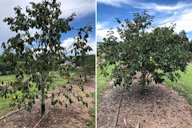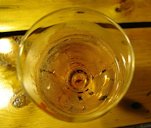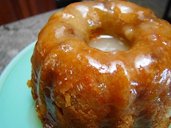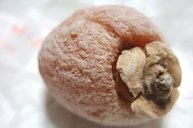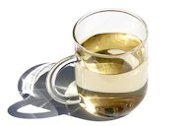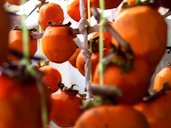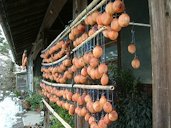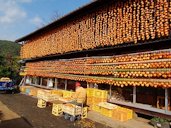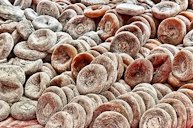| Persimmon Japanese - Diospyros kaki | ||||||||||||||||||||||||||||||||||||||||||||||||||||||||||||||||||||||||
|---|---|---|---|---|---|---|---|---|---|---|---|---|---|---|---|---|---|---|---|---|---|---|---|---|---|---|---|---|---|---|---|---|---|---|---|---|---|---|---|---|---|---|---|---|---|---|---|---|---|---|---|---|---|---|---|---|---|---|---|---|---|---|---|---|---|---|---|---|---|---|---|---|
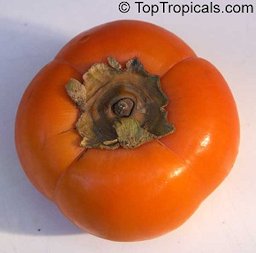 Fig. 1 Diospyros kaki
 'Fuyu' persimmon 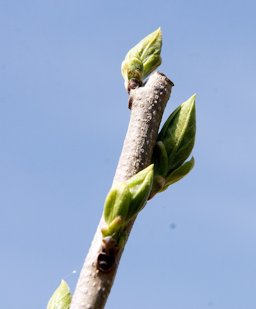 Fig. 3  D. kaki, Behnke Nurseries, Beltsville, MD USA  Fig. 4  Leaf habit 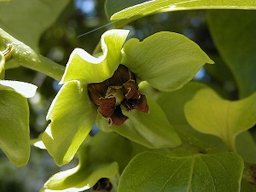 Fig. 8  D. kaki, Real Jardín Botánico, Madrid 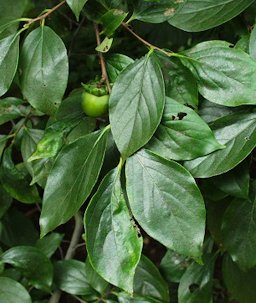 Fig. 15  Persimmon fruit and leaves 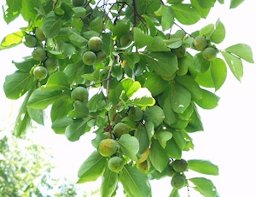 Fig. 16  Fruit habit 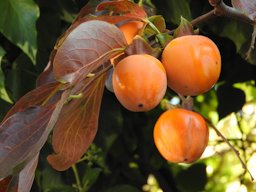 Fig. 17  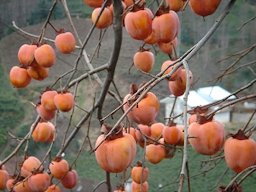 Fig. 18  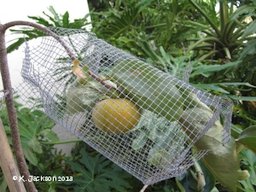 Fig. 19  Protecting your fruit from critters 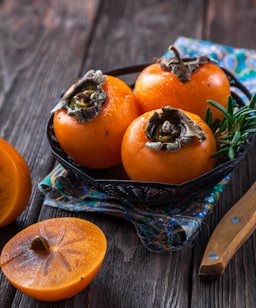 Fig. 26  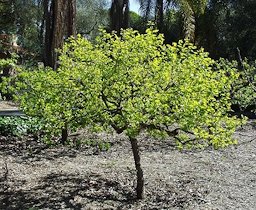 Fig. 27  D. kaki tree 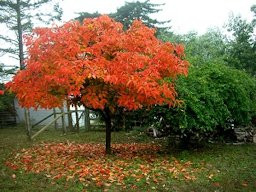 Fig. 28  Tree in full fall color, Sebastopol, California 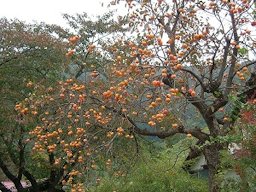 Fig. 29  Persimmons in Nakagawa, Nanyo City, Yamagata Prefecture, Japan 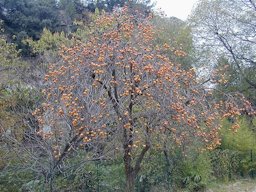 Fig. 30  Plaqueminier (D. kaki) et ses kakis dans un jardin de Saint-Bonnet-du-Gard (Gard, Languedoc-Roussillon, France) 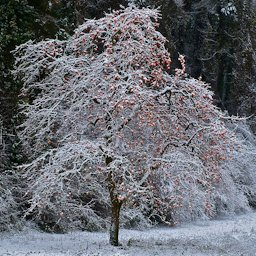 Fig. 31  Kaki, Cascina (Pisa), Italia 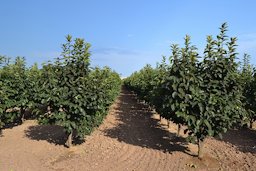 Fig. 33  Camp de caquiers prop de l'ermita, Foios 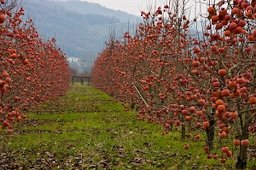 Fig. 34  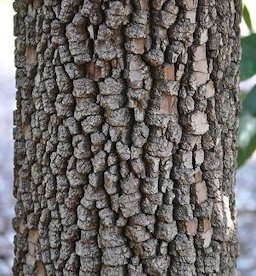 Fig. 35 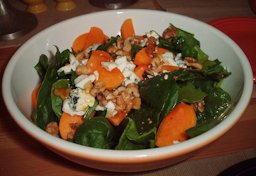 Fig. 36  Spinach and persimmon salad 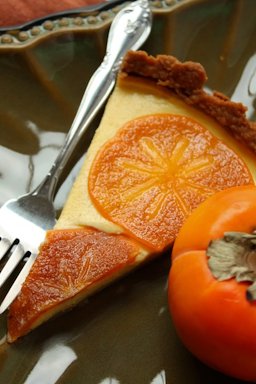 Fig. 37  A jewel-like spiced persimmon tart  Fig. 38  Steamed persimmon pudding with nutmeg hard sauce and candied persimmon slices  Fig. 45  My Japanese mother-in-law prepared some Hachiya Persimmons for drying, to become hoshigaki (dried persimmons) 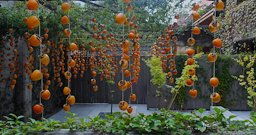 Fig. 46  Benu - persimmons drying in the courtyard (hoshigaki) 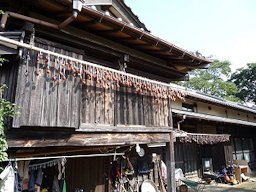 Fig. 47  Japanese persimmons hung to dry after fall harvest 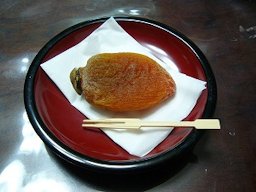 Fig. 48 
Dried 'Kaki' fruit or Hoshigaki 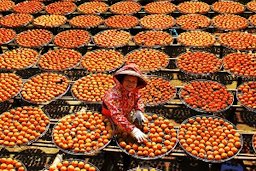 Fig. 54   Fig. 58  This persimmon is mine, Western bluebird, Sialia mexicana  Fig. 59  Japanese Persimmon (D. kaki) In training since 1893 |
Scientific
name Diospyros kaki L. Pronunciation dye-OSS-pih-ross KACK-eye 5 Common names English: Chinese persimmon, Japanese persimmon, kaki, kaki persimmon, Oriental persimmon; French: rague mine; German: Kakibaum, Kakipflaume; Malay: pisang kaki, caqui; Spanish: kaki del Japón, placa minera; Swedish: kaki; Transcribed Chinese:shi; Transcribed Korean: gamnamu 8 Synonyms D. kaki var. aurantium André; D. kaki var. domestica Makino; D. kaki var. elliptica André; D. kaki var. glabra A.DC.; D. kaki var. kaki; D. kaki var. macrantha Hand.-Mazz.; D. kaki var. silvestris Makino 7 Relatives Black Sapote (D. digyna), mabolo, velvet apple (D. discolor), date plum (D. lotus), Texas persimmon (D. texana), American persimmon (D. virginiana) Family Ebenaceae (ebony family) Origin Asia (China, Japan) USDA hardiness zones 7a-9a Uses Usually eaten fresh; or dried for storage and later consumption; container or planter; landscape specimen 4,5 Height 20-30 ft (6.1-9.1 m) Spread 15-25 ft (4.6-7.6 m) Crown Symmetrical; round; dense 5 Plant habit Erect or semi-erect, sometimes crooked or willowy 3 Growth rate Moderate Longevity 50-150 years Trunk/bark/branches Branches droop; typically multi-trunked 5 Pruning requirement Pruning secondary branches so that bearing shoot stay close to the main branches will help reduce drooping Leaves Deciduous; alternate; simple; serrate; entire; 4-8 in. (10.2-20.3 cm) 5 Flower White/creamy/grey; not showy 5 Fruit Round, conical, oblate, or nearly square; fleshy; orange, red, yellow; fruit borne on the current season's branch growth 3,5 Season Aug. to early winter 6 USDA Nutrient Content: raw, dry pdf Light requirement Full sun Soil tolerances Clay; sand; loam; acidic; alkaline; well-drained 5 pH preference 6.5-.5 1 Drought tolerance Tolerant of occasional drought conditions 10 Aerosol salt tolerance Low Soil salt tolerance Low Cold tolerance 20 °F (-6.67 °C) Plant spacing 15 ft (4.5 m) between trees; 20 ft (6 m) between rows 10 Roots Not a problem; tap root if grafted to D. virginiana Invasive potential * Little invasive potential Pest/disease resistance Resistant to pests/diseases Verticillium wilt susceptibility Susceptible Known hazard A trouble-free tree, but messy in fruit 5 Reading Material Japanese Persimmon Cultural Practices in Florida, University of Florida pdf Japanese or Oriental Persimmon, Diospyros kaki, University of Hawai'i Japanese Persimmon, University of Florida pdf The holidays mean persimmons, The Botanist in the Kitchen Japanese Persimmon, Fruits of Warm Climates Japanese Persimmon, Manual Of Tropical And Subtropical Fruits Oriental persimmon has been grown throughout Florida and other Gulf coast states for many years. At one time an estimated 22,000 trees were grown in Florida alone. Today, there are a few hundred acres of persimmon in Florida; however, the crop has great potential to expand commercially. There are new cultivars available, especially of the non-astringent type that are very tasty and amenable to shipment. Oriental persimmon is also a popular dooryard fruit that is relatively easy to grow. 3 Origin The tree is native to Japan, China, Burma and the Himalayas and Khasi Hills of northern India. In China it is found wild at altitudes up to 6,000-8,000 ft (1,830-2,500 m) and it is cultivated from Manchuria southward to Kwangtung. Early in the 14th Century, Marco Polo recorded the Chinese trade in persimmons. Korea has long-established ceremonies that feature the persimmon. Culture in India began in the Nilgiris. The tree has been grown for a long time in North Vietnam, in the mountains of Indonesia above 3,500 ft (1,000 m) and in the Philippines. It was introduced into Queensland, Australia, about 1885. 3 Description Persimmons are one of the loveliest trees to be found. They have smooth, gray to tan bark, and broad, leathery, jade-green leaves (2-3 inches wide and 4-6 inches long). The large varieties average 25 to 30 feet at maturity, a good size for lining driveways and paths, or as a specimen or accent tree. The small ones are usually very heavy bearers, and are great in small groups in the shrubbery border, with low annuals or ground cover beneath them. All persimmons have spectacular fall colors (Fig. 28) -- bright yellows to clear oranges, light pinks to fire-engine reds -- and the whole show happens just as the fruit colors up! 2 Leaves Persimmon leaves are alternate, simple, ovate and up to 7 inches long and 4 inches wide. They are often pale, slightly yellowish green in youth, turning a dark, glossy green as they age. Under mild autumn conditions the leaves often turn dramatic shades of yellow, orange and red. Tea can also be made from fresh or dried leaves. 1
Flowers The inconspicuous flowers surrounded by a green calyx tube are borne in the leaf axils of new growth from one-year old wood. 1 Male and female flowers are usually borne on separate trees; sometimes perfect or female flowers are found on male trees, and occasionally male flowers on female trees. Male flowers, in groups of 3 in the leaf axils, have 4-parted calyx and corolla and 24 stamens in 2 rows. Female flowers, solitary, have a large leaflike calyx, a 4-parted, pale-yellow corolla, 8 undeveloped stamens and oblate or rounded ovary bearing the style and stigma. Perfect flowers are intermediate between the two. 3 A tree's sexual expression can vary from one year to the other. Many cultivars are parthenocarpic, although some climates require pollination for adequate production. When plants are pollinated, they will produce fruits with seeds and may be larger and have a different flavor and texture than do their seedless counterparts. 9
Fig. 9,10,11. Female persimmon flower Fig. 12. Male persimmon flowers Fig. 13. Persimmon shoots with flowers Fig. 14. Bee on a persimmon Bblossom Growth and Development Stages of Four Japanese Persimmon Varieties in North Florida, University of Florida pdf Pollination To sum up conditions as they are at present in the Lower South, and based on numerous observations extending over more than a decade, it is a fact that trees of all varieties of D. kaki, in good health and which bloom under normal weather conditions, can be depended upon to bear good crops if pollinated and it is equally true (a few varieties only excepted) that they will not do so if pollen is not provided. In the last two seasons it has been amply demonstrated that all that is necessary is to have staminate flowering trees in proximity to the pistillate ones and bees, wasps, flies and other insects will take care of the problem according to nature's own plan. It may be mentioned that Tanenashi, normally a seedless variety, fruits well without pollination, and it is thought that Tamopan may do the same. 6 Some cultivars in certain locations and under some conditions, will fruit abundantly without cross-pollination, but this trait is not dependable. In commercial groves, the cultivar known as 'Gailey', which regularly produces many male flowers, is interplanted to insure adequate pollination. The formula is one male for every 8 female trees, uniformly dispersed throughout the grove. 3 Fruit The fruit are large and round, about 3" across, bright orange, with either a pointed end or flattened end. There are about 1000 known varieties, but the most common in the West are 'Hachiya' and 'Fuyu'. 1 Persimmons are classified into two types, astringent and nonastringent, based on fruit characteristics. Astringent cultivars have a taste that puckers the mouth, numbs the tongue, and constricts the throat. This taste is caused by astringent substances such as tannins. Fruit of the nonastringent types lose astringency while still hard and can be eaten hard or soft. 11 Freezing the fruit overnight and then thawing softens the fruit and also removes the astringency. 1
Fig. 20. D. kaki Fuyu young fruit Fig. 21. A 'Hachiya' and 'Kaki' persimmon next to each other Fig. 23. This is a properly sound, ripe fruit with its flesh soft enough to permit one to lift the calyx out cleanly and easily and split it for eating Fig. 24. Persistent calyx Varieties Japanese Persimmon Cultivars in Florida, University of Florida pdf Alleviating Astringency in Persimmon Fruit for Enhanced Palatability and Consumer Acceptability, University of Florida pdf Fruit Shape The three general fruit shapes are conic (cone-shaped), roundish (round and sometimes pointed at the apex like an acorn), and oblate (flattened like a large standard tomato). Some cultivars have other noticeable character-istics, such as an indented ring around the fruit of ‘Midia’ and ‘Tamopan’. Four sides will sometimes be apparent on fruit of ‘Great Wall’ or ‘Saijo’. Distinctly lobed sections are present on ‘Sheng’ and ‘Peiping’. Some cultivars are tucked or folded in at the calyx, like ‘Suruga’. 11
Fig. 25. Different fruit shapes among persimmon cultivars Harvesting Harvest season for astringent persimmon fruit is just prior to and through the soft stage of fruit development. If picked during this time, the fruit is either soft or will become soft, and the astringent tannins are coagulated, making the fruit suitable for eating. Generally, fruit can be picked and softened at room temperature about 7 to 10 days before it would soften on the tree. 11 Choosing the proper harvest season for nonastringent persimmons is less complicated than for the astringent types because they can be eaten firm. The astringent tannins are broken down earlier in the fruit-development period at a time when the fruit is still hard. 11 Persimmons are harvested when mature but still firm, with color nearly fully developed. 'Maru' fruit is greenish yellow when ripe; 'Fuyu' and 'Hachiya' fruits are orange. The fruit is removed from the tree by clipping or breaking the stems, leaving the calyx lobes attached to the fruit. Persimmons must be handled carefully to avoid damage. Rough handling causes bruising and skin discoloration. 4
Harvesting Oriental Persimmons, Aggie Horticulture® Protect Your Fruits & Nuts from Squirrels & Other Varmints Storage Generally, because astringent persimmons must be soft or near that state at harvest, they do not store well; however, nonastringent types can store up to 30 days at room temperature. Colors will increase somewhat, sugar will remain the same, and weight will decline 7% to 10%. Only fruit without imperfections store well over a long period. Generally, the early-maturing cultivars such as ‘Izu’ have a shorter shelf life than late-season ones like ‘Fuyu’. In Japan, fruit are individually wrapped in thin polyethylene and stored at 32°F for 4–5 months. The fruit will still be of good quality when removed from storage. 11 Freezing is a popular method of preserving persimmons. They can be peeled before freezing and frozen whole or pureed in plastic containers. In this manner, they will keep for a year or more. 12 Persimmon harvesting, ripening, and preservation strategies, UF/IFAS NFREC Dried Persimmon Fruit: A Year-round Available Product, University of Florida pdf Propagation Diospyros kaki seedlings are the preferred rootstocks for persimmon cultivars. They develop long taproots with few fibrous laterals, and rootstock cultivars have been selected that produce vigorous, uniform seedlings. Rootstocks of D. virginiana (American persimmon) and D. Iotus (date plum) are known to be better for wet soils, but the former produces variable trees and excessive suckering. D. Iotus is susceptible to crown gall and is incompatible with the 'Fuyu' cultivar as rootstocks or scionwood. 4 Japanese persimmons in Florida have nearly exclusively been grafted onto D. virginiana, the native persimmon of the United States. D. virginiana is widely used in the southern states due to its adaptability to different soil types. It provides a tolerance of wet soils, is cold hardy, can withstand drought conditions, and is compatible with most scion cultivars. It tends to produce more suckers compared with other common rootstocks used in California, such as D. lotus and D. kaki, and can also lack uniformity and vigor. 10 The two common methods of joining the scion and rootstock of persimmons are whip grafting and chip budding. Whip grafting can best be performed during the dormant season. Scion material with two buds provides good results, and the graft union is wrapped with tape or rubber bands. 10
Tree Size and Shape Semi-dwarf plants reach a height of around 6 to 8 ft and have a rounded spreading top (Fig. 27). 'Makawa Jiro' and 'Ichikikei-Jiro' are examples of this type. Trees of medium size tend to be taller with more upright shoots. Their limbs are usually spread with crop loads. By far, most persimmon trees fall into this category. Trees in the tall class are upright and often have small fruit. Generally, tree size is reduced south of Gainesville to south Florida. It has been observed that trees grown in Florida are often smaller than would be expected in their native land; common cultivars barely reached 10 ft in height after 10 years in trials during the 1960s.11
Fig. 32. Tree size and shape can be varied among cultivars 'Saijo' (left) and 'Fuyu' (right). Culture Persimmons have a low chilling require-ment, with success in areas that receive only 100–200 hours below 45°F (7°C), and data shows that bud dormancy may be best released at temperatures just above the normal chilling range of 32°F–45°F (0°C–7°C). 10 Trees grow and fruit best in central and northern Florida and can produce high yields of good-quality fruit. In south Florida, fruit quality is better with astringent types than with nonastringent types. 10 Well-drained, sandy loam soils are preferred, but persimmons will grow on many soil types if good drainage is provided. Persimmon will grow more vigorously and produce more fruit in full sun. Avoid frost pockets – trees may be damaged by unseasonable frosts. 2 Pruning Persimmons in the South are usually pruned to an open center habit. At planting select 3-4 scaffold branches spaced equally around the trunk and remove other branches flush with the trunk. In the second dormant season, top the scaffold limbs approximately 36 inches from the trunk to encourage secondary branching. Remove any strong branches growing into the center. You want the tree to have good air circulation in the interior. Continue to train persimmon trees during the first 5 years. Pruning should be designed to train the tree outward by removing strong branches growing into the center and removing water sprouts. The tree can be topped out at 7 or 8 foot with mold and hold cuts, which are devigorating heading cuts made into two year old wood. Do this by topping back the main scaffold limb to a weaker outward growing shoot. This will keep the tree at an easy picking height as well as stimulate new growth lower on the tree. 2
Fertilizing Fruit drop is a common problem for persimmons in the South. High nitrogen fertilizer or uneven watering patterns can cause this problem. Some varieties are more prone to fruit drop when young, but grow out of it with age. Make sure that the fertilizer contains iron, zinc, manganese, magnesium, molybdenum, copper and boron. These minor elements are very important to plants and most soils are low in these elements. 2 Irrigation The first year is a critical time for the establishment of a new persimmon. Water thoroughly twice a week on light soils and once a week on clay soils. Soak the entire root system deeply – this usually takes 40-50 minutes. Persimmons should receive at least 1 inch of water each week for best growth and fruit production. 2 It is still essential that water is available to the trees during their main growth phase in the first few months of the season. Overwatering encourages vegetative growth during the flowering and fruiting stage, and it can result in increased fruit shedding. 10 Pest page Food Uses Fully ripe Japanese persimmons are usually eaten out-of-hand or cut in half and served with a spoon, preferably after chilling. Some people prefer to add lemon juice or cream and a little sugar. The flesh may be added to salads, blended with ice cream mix or yogurt, used in pancakes, cakes, gingerbread, cookies, gelatin desserts, puddings, mousse, or made into jam or marmalade. The pureed pulp can be blended with cream cheese, orange juice, honey and a pinch of salt to make an unusual dressing. Ripe fruits can be frozen whole or pulped and frozen in the home freezer. 3 Fruit may be converted into molasses, cider, beer and wine. 9
Fig. 39. Persimmon iine in the Daegu Wine Tunnel Winery, South Korea Fig. 40. Persimmon bundt with walnuts Fig. 41. Dried persimmon and chestnut from Nakatsugawa Fig. 42. Easy persimmon pudding Fig. 43. Persimmon loaf cake Fig. 44 Thé de feuille de plaqueminier How to Make Hoshigaki (Dried Persimmons)
Fig. 49. Hoshigaki, Japanese traditional dried persimmon Fig. 50. Dried persimmon in the making Fig. 51. Dried Asian persimmons in Xi'an, China Fig. 52. Work to make a dried persimmon, Koshu-city Japan Fig. 53. Dried persimmon Singapore
Medicinal Properties ** A decoction of the calyx and fruit stem is sometimes taken to relieve hiccups, coughs and labored respiration. 3 Other Uses Tannin from unripe Japanese persimmons has been employed in brewing sake, also in dyeing and as a wood preservative. Juice of small, inedible wild persimmons, crushed whole, calyx, seeds and all, is diluted with water and painted on paper or cloth as an insect- and moisture-repellent. 3 The wood of the tree is fairly hard and heavy, black with streaks of orange-yellow, salmon, brown or gray; close-grained; takes a smooth finish and is prized in Japan for fancy inlays, though it has an unpleasant odor. 3
Fig. 55. Korean chest with persimmon wood panels Fig. 56. 1965 Commerative stamp of Albania Fig. 57 Matsuzato Koro-Gaki of dried persimmon for gifts General The astringent substance in the persimmon, generally called "tannin", has been much studied and variously defined as knowledge of tannins and other phenols has unfolded. To put it simply, it is classed as a condensed tannin (proanthocyanidin) of complex structure. 3 From the Greek diospyros, composed of dios (divine), and pyros (grain), from the edible fruit of some species. The specific epithet is derived from the Japanese word for plant, kaki-no-ki. 9 Persimmon names often represent an approximation of the various Asian-language names by which the original imported trees were designated. Today, we have a number of cultivars with Asian-language or pseudo-Asian-language names and meanings, as well as some with American English-derived names. Some of the Asian-language-derived words used have the following meanings: “Kaki” or “Gaki”- persimmon; “Wase”—early; “Hana”—flower of; “Tanenashi”—without seed; “Fuyu”—winter; “Saijo”—best; “Gosho”—imperial palace; “Ichi”—number one; and “Ki”—life. 11 Other Edibles in the Diospyros genus: Black sapote, D. digyna American Persimmon, D. virginiana Mabolo, D. blancoi Further Reading Add Fruit To The Landscape with Oriental Persimmon, University of Florida pdf Diospyros kaki, Agroforestry Database Home Garden: Persimmons, University of Georgia Extension pdf Persimmon, Just Fruits and Exotics nursery Persimmon, California Rare Fruit Growers Persimmons, Aggie Horticulture® pdf Oriental Persimmons, Mississippi State University Extension pdf Persimmons, Asian and American, National Sustainable Agriculture Information Service pdf Persimmon Production in China, Archives of the Rare Fruit Council of Australia The Oriental Persimmon, Archives of the Rare Fruit Council of Australia Japanese Persimmon Botanical Art List of Growers and Vendors |
|||||||||||||||||||||||||||||||||||||||||||||||||||||||||||||||||||||||
| Bibliography 1 "Persimmon." California Rare Fruit Growers, 1969-1989, crfg.org. Accessed 27 May 2014. 2 "Persimmon." Just Fruits and Exotics, justfruitsandexotics.com. Accessed 9 Mar. 2015. 3 Fruits of Warm Climates. Julia F. Morton, Miami, 1987. 4 "General Information Crop." Hawaii Cooperative Extension Service, University of Hawai'i, CTAHR, extento.hawaii.edu. Accessed 26 Dec. 2013. 5 Gilman, Edward F., and Dennis G. Watson. "Diospyros kaki: Japanese Persimmon." Environmental Horticulture Dept., UF/IFAS Extension, ENH388, Original pub. Nov. 1993, Reviewed May 2014, AskIFAS, edis.ifas.ufl.edu. Accessed 21 Dec. 2016. 6 Popenoe, Wilson. Manual Of Tropical And Subtropical Fruits. 1920, London, Hafner Press, 1974. 7 "Diospyros kaki synonyms." The Plant List (2010), Version 1, theplantlist.org. Accessed 1 Mar. 2017. 8 "Diospyros kaki common names." USDA Agricultural Research Service, U.S. National Plant Germplasm System, GRIN-Global, npgs.ars-grin.gov/gringlobal/taxonomydetail.aspx?id=14293. Accessed 8 Nov. 2018. 9 Orwa C., et al. "Diospyros kaki (L.)" Agroforestree Database: a tree reference and selection guide, version 4.0, 2009. www.worldagroforestry.org/treedb2/speciesprofile.php?Spid=18048#. Accessed 13 July 2018. 10 Sarkhosh, Ali, et al. "Japanese Persimmon Cultural Practices in Florida." Horticulture Science Dept., UF/IFAS Extension, HS1389, Released 20 Oct. 2020, Reviewed 27 Sept. 2023, AskIFAS, doi.org/10.32473/edis-hs1389-2020, edis.ifas.ufl.edu/hs1389. Accessed 27 Feb. 2021, 31 Oct. 2024. 11 Sarkhosh, Ali, et al. "Japanese Persimmon Cultivars in Florida." Horticulture Science Dept., UF/IFAS Extension, SP101, Released 27 Feb. 2020, Reviewed 21 Feb. 2023, AskIFAS, doi.org/10.32473/edis-mg242-2020, edis.ifas.ufl.edu/ publication/mg242. Accessed 27 Feb. 2021, 2 Sept. 2024. 12 Rodrigez, David. "Harvesting Oriental Persimmons." Aggie Horticulture®, Texas A&M AgriLife Extension, 15 Jan. 2005, aggie-horticulture.tamu.edu. Accessed 27 May 2014. Videos v1 "How To Ripen And Eat A Persimmon - Fuyu Non-Astringent Persimmon." The Millennial Gardener, 31 Jan. 2020, (CC0), www.youtube.com/watch?v=adwzuRSd-Xg. Accessed 23 Nov. 2021. v2 Raddi, Ross. "Grafting Persimmon Trees: A few points." Toss Raddi Blog, 7 June 2019, (CC0), www.youtube.com/watch?v=ur1PcxYpPns. Accessed 23 Nov. 2021. v3 "Pruning the Rosseyanka and Nakitas Gift Persimmon trees." HEPPY lifestyle, (CC BY 3.0), www.youtube.com/watch?v=n8uCSLgBak8. Accessed 17 May 2021. v4 Klocek, Dennis. "Making Hoshigaki - Japanese Dried Persimmons." Soil, Soul and Spirit, 17 Dec. 2017, (CC0), www.youtube.com/watch?v=O95v1N8cgHM. Accessed 17 May 2021. v5 "It’s a red mountain, and in the fall, it’s natural to make some sweet persimmons." Liziqi, 8 Oct. 20218, (CC BY 3.0), www.youtube.com/watch?v=QHTnuI9IKBA. Accessed 13 June 2021. Photographss Fig. 1,13 "Persimmon." Top Tropicals, toptropicals.com. Accessed 27 May 2014. Fig. 2 Olegivvit. "Persimmon." Wikimedia Commons, 2006, (CC BY-SA 2.5), commons.wikimedia.org. Accessed 22 Dec. 2016. Fig. 3 Stang, David J. "Diospyros kaki, Behnke Nurseries, Beltsville, MD USA. " Wikimedia Commons, via ZipcodeZoo, 25 Apr. 2007, (CC BY-SA 4.0), Image cropped, commons.wikimedia.org/File:Diospyros_kaki_6zz.jpg. Accessed 24 Nov. 2021. Fig. 4,15,16,27,35 Gillum, A., et al, SelecTree. "Diospyros kaki. 'Fuyu' Photo Record." Urban Forest Ecosystems Institute, 1995-2012, selectree.calpoly.edu. Accessed 11 Mar 2015. Fig. 5 Sánchez, Luis Miguel Bugallo. "Folla, hoja, folha, leaf (Galicia - Spain)." Wikimedia Commons, 2005, (CC BY-SA 3.0), commons.wikimedia.org. Accessed 1 Mar. 2017. Fig. 6 FASTILY. "Diospyros kaki." Wikimedia Commons, 15 May 2017, (CC BY-SA 4.0), commons.wikimedia.org/File:Diospyros_kaki_3_2017-05-14.jpg. Accessed 24 Nov. 2021. Fig. 7 Saadkhan12345. "Persimmon plant leaves." Wikimedia Commons, 19 July 2016, (CC BY-SA 4.0), commons.wikimedia.org/File:Persimmon_leaves_2222.jpg. Accessed 24 Nov. 2021. Fig. 8 Barra. A. "Diospyros kaki. Real Jardín Botánico, Madrid." Wikimedia Commons, 2001, (CC BY 3.0), commons.wikimedia.org. Accessed 1 Mar. 2017. Fig. 9,10,11 "Flowering." Japanese Persimmon Cultural Practices in Florida, Environmental Horticulture Dept., UF/IFAS Extension, HS1389, Original pub. Oct. 2020, AskIFAS, edis.ifas.ufl.edu/hs1389. Accessed 27 Feb. 2021. Fig. 12 MR. "Persimmon flower." Top Tropicals, toptropicals.com. Accessed 10 Mar. 2015. Fig. 14 Jo Zimny Photos. "Bee On A Persimmon Blossom." Flickr, 18 June 2021, (CC BY-NC-ND 2.0), www. flickr.com/photos/joeyz51/51255059576/. Accessed 23 Nov. 2021. Fig. 17 "Japanese Persimmon (Diospyros kaki)." PxHere, 6 Feb. 2017, (CC0) Public Domain, pxhere.com/en/photo/626013. Accessed 23 Nov. 2021. Fig. 18 Karduelis. "Dispyros kaki." Wikimedia Commons, 2007, Public Domain, commons.wikimedia.org. Accessed 22 Dec. 2016. Fig. 19 Jackson, Karen. "Persimmon Series." 2014, www.growables.org. Fig. 20 Tain, Puddin. "Diospyros kaki Fuyu young fruits." Flickr, 26 Apr. 2020, (CC BY-SA 2.0), www.flickr.com/photos/puddintain850/49822881611/. Accessed 23 Nov. 2021. Fig. 21 Tduk, Lozupone, Alex "A 'Hachiya' and 'Kaki' persimmon next to each other." Wikimedia Commons, 2010, (CC BY-SA 3.0), commons.wikimedia.org. Accessed 10 Mar. 2015. Fig. 22 Richfield, Jon. "Diospiros kaki Fruit." Wikipedia, 2012, (CC BY-SA 3.0), wikipedia.org. Accessed 27 May 2014. Fig. 23 Haneburger. "Mature Kaki fruits." Wikimedia Commons, 2009, GFDL, commons.wikimedia.org. Accessed 22 Dec. 2016. Fig. 24 "Japanese Persimmon (Diospyros kaki)." PxHere, 16 Mar. 2017, (CC0) Public Domain, pxhere.com/en/photo/1162217. Accessed 23 Nov. 2021. Fig. 25 Sarkhosh, Ali. "Different fruit shapes among persimmon cultivars." Japanese Persimmon Cultivars in Florida, Environmental Horticulture Dept., UF/IFAS Extension, SP101, Original pub. Apr. 1994, Revised Feb. 2020, AskIFAS, Image cropped, doi.org/10.32473/edis-mg242-2020, edis.ifas.ufl.edu/ publication/mg242. Accessed 27 Feb. 2021. Fig. 26 "Japanese Persimmon (Diospyros kaki)." PxHere, 15 Jan. 2017, (CC0) Public Domain, pxhere.com/en/photo/397132. Accessed 23 Nov. 2021. Fig. 28 ATIS547. "Persimmon Tree Foliage. Sebastopol, California." Flickr, 2007, (CC BY-NC-SA 2.0), www.flickr.com. Accessed 27 May 2014. Fig. 29 Cla68. "Persimmons in Nakagawa, Nanyo City, Yamagata Prefecture, Japan." Wikimedia Commons, 29 Oct. 2008, (CC BY-SA 3.0), commons.wikimedia.org. Accessed 10 Mar. 2015. Fig. 30 Semnoz. "Plaqueminier (Diospyros kaki) et ses kakis dans un jardin de Saint-Bonnet-du-Gard (Gard, Languedoc-Roussillon, France)." Wikimedia Commons, (CC BY-SA 3.0), commons.wikimedia.org. Accessed 1 Mar. 2017. Fig. 31 Carrani, Francesco. " Kaki, Cascina (Pisa), Italia." Wikimedia Commons, via Flickr, 19 Dec. 2010, (CC BY 2.0), commons.wikimedia.org/File:Kaki_-_Flickr_-_kekko64.jpg. Accessed 24 Nov. 2021. Fig. 32 Sarkhosh, Ali. "Tree size and shape can be varied among cultivars 'Saijo' (left) and 'Fuyu' (right)." Japanese Persimmon Cultivars in Florida, Environmental Horticulture Dept., UF/IFAS Extension, SP101, Original pub. Apr. 1994, Revised Feb. 2020, AskIFAS, Image cropped, doi.org/10.32473/edis-mg242-2020, edis.ifas.ufl.edu/ publication/mg242. Accessed 27 Feb. 2021. Fig. 33 Joanbanjo. "Camp de caquiers prop de l'ermita, Foios." Wikimedia Commons, 17 July 2020, (CC BY-SA 4.0), commons.wikimedia.org/File:Camp_de_caquiers_prop_de_l%27ermita,_Foios.jpg. Accessed 24 Nov. 2021. Fig. 34 Oblak, Boris. "Kaki crw 8247." Wikimedia Commons, 2007, GFDL, commons.wikimedia.org. Accessed 1 Mar. 2017. Fig. 36 erinsikorskystewart. "Spinach and persimmon salad." Flickr, 5 Nov. 2006, (CC BY-NC 2.0), www. flickr.com/photos/89239849@N00/291280914/. Accessed 23 Nov. 2021. Fig. 37 Baker, Tara. "A jewel-like spiced persimmon tart." A Baking Life (gluten free), 2 Nov. 2020, (CC BY-NC-ND 3.0). abakinglife.thedailymeal.com/2010/11/once-upon-time.html. Accessed 23 Nov. 2021. Fig. 38 distopiandreamgirl. "Steamed persimmon pudding with nutmeg hard sauce and candied persimmon slices." Flickr, 13 Nov. 2021, (CC BY-NC-ND 2.0), www. flickr.com/photos/probonobaker/6343039697/. Accessed 23 Nov. 2021. Fig. 39 Eckert, Ken. "Persimmon Wine in the Daegu Wine Tunnel Winery, South Korea." Wikimedia Commons, 2013, (CC BY-SA 4.0). commons.wikimedia.org. Accessed 1 Mar. 2017. Fig. 40 Hudson, Janet. "Persimmon Bundt with Walnuts." Flickr, 2009, (CC BY 2.0), www.flickr.com. Accessed 1 Mar. 2017. Fig. 41 tokyofoodcast.com. "Dried persimmon & chestnut from nakatsugawa." Flickr, 2010, (CC BY-NC 2.0), www.flickr.com. Accessed 1 Mar. 20s17. Fig. 42 Manoj, Suja. "Easy Persimmon Pudding." Kitchen Corner, (CC BY-NC-SA 3.0), kichencorner.blogspot.com/2019/12/easy-persimmon-pudding.html. Accessed 23 Nov. 2021. Fig. 43 Raymond. "Persimmon loaf cake." Ang Sarap, 26 Sept. 2016, (CC BY-NC-ND 3.0), www.angsarap.net/2016/09/26/persimmon-loaf-cake/. Accessed 23 Nov. 2021. Fig. 44 Jpbrigand." Thé de feuille de plaqueminier. " Wikimedia Commons, 26 July 2017, (CC BY-SA 4.0), Image cropped, commons.wikimedia.org/File:Thé_de_plaqueminier.jpg. Accessed 24 Nov. 2021. Fig. 45 Tachikoma805. "My Japanese Mother-in-law prepared some Hachiya Persimmons for drying, to become hoshigaki (dried persimmons)." Wikimedia Commons, 2009, (CC BY 3.0), commons.wikimedia.org. Accessed 10 Mar. 2015. Fig. 46 Infoedits. "Benu - persimmons drying in the courtyard (hoshigaki)." Wikimedia Commons, 1 Nov. 2014, (CC BY-SA 4.0), commons.wikimedia.org/File:Benu_-_persimmons_drying_in_the_courtyard.jpg. Accessed 24 Nov. 2021. Fig. 47 Cla68. "Japanese persimmons hung to dry after fall harvest." Wikimedia Commons, 2008, Public Domain, commons.wikimedia.org. Accessed 10 Mar. 2015. Fig. 48 Searobin. " Dried 'Kaki' fruit." Wikimedia Commons, 2005, (CC BY-SA 3.0), commons.wikimedia.org. Accessed 10 Mar. 2015. Fig. 49 AOYAMA, jun. "Hoshigaki. Japanese traditional dried persimmon." Flickr, (CC BY 2.0), www.flickr.com. Accessed 1 Mar. 2017. Fig. 50 Midori, Sakurai. "民家の軒先に吊るされた干し柿、岐阜県 Dried persimmon in the making." Wikimedia Commons, 2006, (CC BY-SA 3.0), GFDL, commons.wikimedia.org. Accessed 22 Dec. 2016. Fig. 51 Greg. "Dried Asian persimmons in Xi'an, China." Wikimedia Commons, via flickr.com, 2005, (CC BY 2.0), commons.wikimedia.org. Accessed 10 Mar. 2015. Fig. 52 さかおり. "Work to make a dried persimmon Koshu-city Japan." Wikimedia Commons, 2010, (CC BY-SA 3.0), commons.wikimedia.org. Accessed 1 Mar. 2017. Fig. 53 Choo Yut Shing. "Dried persimmons." Flickr, 2017, (CC BY-NC-ND 2.0), www.flickr.com. Accessed 1 Mar. 2017. Fig. 54 Lee Tzung-Tze. "Dried Persimmon Lady." Flickr, 2006, www.flickr.com. Accessed 10 Mar. 2015. Fig. 55 Wildbarbara. "Korean chest with persimmon wood panels." Wikimedia Commons, 2006, commons.wikimedia.org. Accessed 10 Mar. 2015. Fig. 56 Post of Albania. '1965 Commemorative Stamp of Albania." Wikimedia Commons, Public Domain, commons.wikimedia.orgwiki/File:Stamp_of_Albania_-_1965_-_Colnect_323055_-_Japanese_Persimmon_Diospyros_kaki.jpeg.. Accessed 23 Nov. 2021. Fig. 57 Sakaori. "Matsuzato Koro-Gaki of dried persimmon for gifts." Wikimedia Commons, 16 Dec. 2012, (CC BY-SA 3.0), GFDL, commons.wikimedia.org/File:Matsuzato_Koro-Gaki_of_dried_persimmon_for_gifts.JPG. Accessed 24 Nov. 2021. Fig. 58 Derevan, Rick. "This Persimmon Is Mine, Western Bluebird, Sialia mexicana." Flickr, 23 Jan. 2013, (CC BY-NC-ND 2.0), www. flickr.com/photos/sheltieboulevard/8526141515/in/photostream/. Accessed 23 Nov. 2021. Fig. 59 Cliff. "Japanese Persimmon (Diospyros kaki) In training since 1893." Flickr, 1 May 2009, (CC BY 2.0), www. flickr.com/photos/nostri-imago/3504613241. Accessed 23 Nov. 2021. * UF/IFAS Assessment of Non-native Plants in Florida's Natural Areas ** Information provided is not intended to be used as a guide for treatment of medical conditions. Published 27 May 2014 LR. Last update 8 Nov. 2024 LR |
||||||||||||||||||||||||||||||||||||||||||||||||||||||||||||||||||||||||
